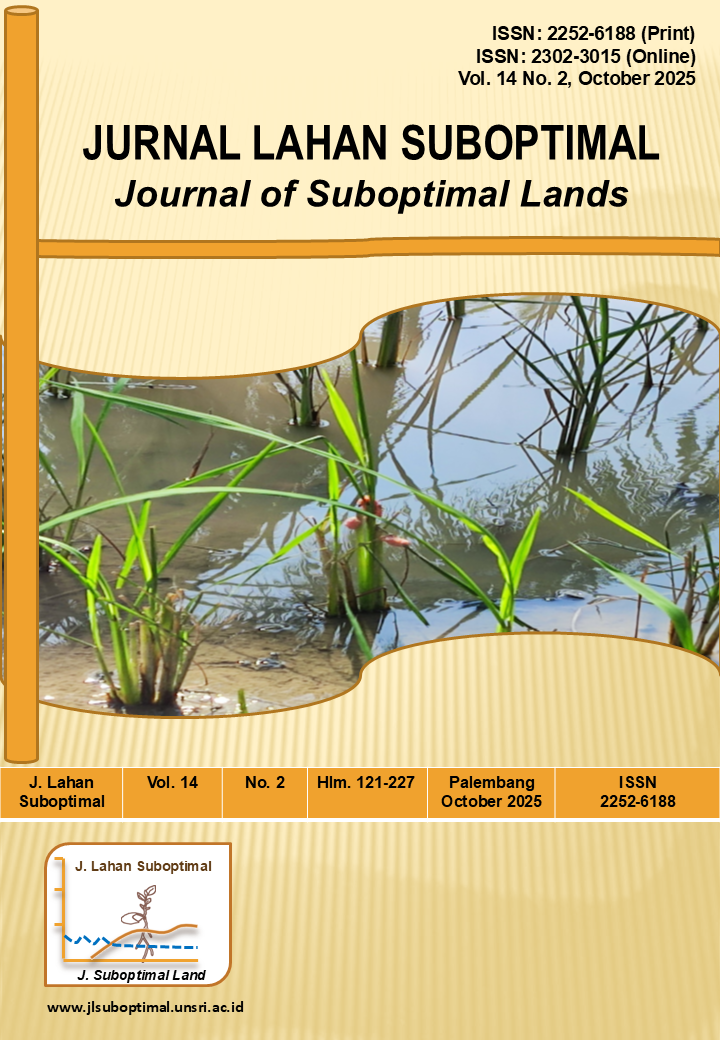Identification of agronomic characters of F1 rice plants derived from crossing Inpara 8 and Inpago 12 varieties
DOI:
https://doi.org/10.36706/jlso.14.2.2025.685Keywords:
agronomic character, Inpago 12, Inpara 8, Oryza sativa, wetlandAbstract
Suboptimal rice productivity in the swamp was due to both drought stress and submergence stress during the lifetime of the rice, and swamp rice could only be planted once a year. One of the efforts to increase the productivity of swamp rice was to develop rice varieties that can tolerate drought stress and submergence stress. The study aimed to validate the success of the F1 cross and to develop rice varieties exhibiting dual tolerance through backcrossing. Data analysis utilized Analysis of Variance followed by 5% test. The planting method uses a Randomized Complete Block Design (RCBD) with three replications. Observed variables included plant height, number of tillers per clump, number of panicles per clump, number of grains per panicle, number of grains per clump, weight of grain per panicle, dry weight of harvested grain, dry weight of grain, weight of 1000 grains, percentage of empty grains, flowering age, and harvesting age. Evaluations of growth characteristics revealed no significant differences in genetic traits and characteristics between the crossed rice and the parental lines. Flowering age and harvesting age of rice Inpago 12 elders were faster than Inpara 8 elders. Plant height of Inpago 12 elders was higher than Inpara 8 elders. This was due to differences in genetic traits and characters between varieties, and finally it was concluded that F1 accessions were successfully crossed and did not single-cross.
References
Alridiwirsah, H, H., M.H, E., & Muchtar Y. (2015). Tolerance test of some varieties of padi (Oryza sativa L.) on shading. Jurnal Pertanian Tropik. Pertanian Tropik, 2(2), 93–101.
Amalya, N. S., Yuniarti, A., Setiawan, A., & Machfud, Y. (2020). The Effect of N, P, K fertilizer and nano silica fertilizer to total N Content, N Uptake, and black rice yield (Oryza sativa L . Indica ) on inceptisols from Jatinangor. Journal of Plant Sciences, 8(5), 185–188.
https://doi.org/10.11648/j.jps.20200805.21
Anhar, R., Hayati, E., Agroteknologi, M., Pertanian, F., Syiah, U., Agroteknologi, D., Pertanian, F., Syiah, U., & Aceh, D. B. (2016). Effect of urea fertilizer dose on growth and production of local rice germplasm of Aceh origin. Jurnal Kawista, 1(1), 30–36.
Balwan, W. K., & Kour, S. (2021). Wetland- an ecological boon for the environment. East African Scholars Journal of Agriculture and Life Sciences, 4(3), 38–48. https://doi.org/10.36349/easjals.2021.v04i03.001
Barokah, U., & Susanto, U. (2020). Response of various rice varieties on organic land with System of Rice Intensification (SRI) in Sragen. Jurnal Agrinika : Jurnal Agroteknologi dan Agribisnis, 4(2), 130‒142. https://doi.org/10.30737/agrinika.v4i2.1065
Crowson, M., Warren-Thomas, E., Hill, J. K., Hariyadi, B., Agus, F., Saad, A., Hamer, K. C., Hodgson, J. A., Kartika, W. D., Lucey, J., McClean, C., Nurida, N. L., Pratiwi, E., Stringer, L. C., Ward, C., & Pettorelli, N. (2019). A comparison of satellite remote sensing data fusion methods to map peat swamp forest loss in Sumatra, Indonesia. Remote Sensing in Ecology and Conservation, 5(3), 247–258. https://doi.org/10.1002/rse2.102
Ekaputra, E. G., Yanti, D., Irsyad, F., & Setyanto, E. (2022). Spatial distribution of rice planting calendar in West Sumatra Province Based on MODIS image data. Andalasian International Journal of Applied Science, Engineering and Technology, 2(1), 1–10. https://doi.org/10.25077/aijaset.v2i1.28
Fahad, S., Adnan, M., Noor, M., Arif, M., Alam, M., Khan, I. A., Ullah, H., Wahid, F., Mian, I. A., Jamal, Y., Basir, A., Hassan, S., Saud, S., Amanullah, Riaz, M., Wu, C., Khan, M. A., & Wang, D. (2018). Major constraints for global rice production. In Advances in Rice Research for Abiotic Stress Tolerance. Elsevier Inc, 1‒22. https://doi.org/10.1016/B978-0-12-814332-2.00001-0
Henni, M. K., & Ardian, M. A. K. (2015). use material of storage and volume giving water on the growth seed oil palm (Elaeis guineensis Jacq.) the main nursery. Jurnal Online Mahasiswa Fakultas Pertanian Universitas Riau, 2(2), 1‒15.
Hermanto, S. R., Aprianingrum, E., Ketapang, P. N., & Ketapang, J. R. S. (2022). Growth of sleeping eye rubber stum seed on peat media. Journal of Agro Plantation, 01(01), 27–33.
Hubert, J., Luzi-kihupi, A., Hébrard, E., & Lyimo, H. J. F. (2016). Farmers’ knowledge and perceptions of rice yellow mottle virus in selected rice growing areas in Tanzania. International Journal of Science and Research, 5(2), 549–559.
Jumakir, J. (2015). The Performance and Results of Strains Harapan Padi in Tidal Marshes. Journal Agroekoteknologi, 7(2), 160–166.
Kamai, N., Omoigui, L. O., & Kamara, A. Y. (2020). Guide to rice production in Northern Nigeria (I. Ibadan (ed.)). International Institute of Tropical Agriculture, p.1‒27.
Kasno, A., Rostaman, T., & Setyorini, D. (2016). Increasing productivity of rainfed rice fields with N, P, and K nutrient fertilization and use of superior rice varieties. Jurnal Tanah Dan Iklim, 40(2), 147–157.
Kato, Y., Collard, B. C. Y., Septiningsih, E. M., & Ismail, A. M. (2019). Increasing flooding tolerance in rice: combining tolerance of submergence and of stagnant flooding. Annals of Botany, 124(7), 1199–1209. https://doi.org/10.1093/aob/mcz118
Khan, S., Anwar, S., Ashraf, M. Y., Khaliq, B., Sun, M., Hussain, S., Gao, Z. Q., Noor, H., & Alam, S. (2019). Mechanisms and adaptation strategies to improve heat tolerance in rice. A Review. Plants, 8(11), 1–21. https://doi.org/10.3390/plants8110508
Kurniawan, H. H., Mulyanto, D., & Nurcholis, M. (2021). The effect of calcite application to several chemical properties of latosol in Patuk Gunung Kidul. Jurnal Tanah dan Air, 18(6), 37–47.
Lakitan, B., Alberto, A., Lindiana, L., Kartika, K., Herlinda, S., & Kurnianingsih, A. (2018a). The benefits of biochar on rice growth and yield in tropical Riparian Wetland, South Sumatra, Indonesia. Chiang Mai University Journal of Natural Sciences, 17(2), 111–126. https://doi.org/10.12982/CMUJNS.2018.0009
Qurani, I. Z., & Lakitan, B. (2021). Inland swamp agriculture: opportunities and challenges. TJF Brief, 18(5), 1–6. https://doi.org/10.6084/m9.figshare.14608230
Rahajeng, S. S., Jayadi, R., & Maas, A. (2022). Assessment of reservoir and canals revitalization to improve the reclamation process at Unit Tamban Tidal Irrigation Area, Central Kalimantan. IOP Conference Series: Earth and Environmental Science, 1091(1), 1‒10. https://doi.org/10.1088/1755-1315/1091/1/012034
Saadah, D. R.,, Zakiyah, M. R. U. M. S. S. (2017). Red algae (Gracilaria coronopifolia) as a potential source of phytohormone cytokinin. Chimica et Natura Acta, 5(3), 124–131.
Sarumaha, M. (2020). Identification of insect pests on rice plants in Bawolowalan Village. Jurnal Education and Development, 8(3), 86–91.
Seleiman, M. F., Al-Suhaibani, N., Ali, N., Akmal, M., Alotaibi, M., Refay, Y., Dindaroglu, T., Abdul-Wajid, H. H., & Battaglia, M. L. (2021). Drought stress impacts on plants and different approaches to alleviate its adverse effects. Plants, 10(2), 1–25. https://doi.org/10.3390/plants10020259
Sembiring, J. A., & Mendes, J. A. (2022). Population of brown stem leafhopper (Nilaparvata lugens) and green planthopper (Nephotettix virescens) on rice plant of Inpara 2 Variety in Bokem Village, Merauke Regency, Papua. Sainmatika: Jurnal Ilmiah Matematika dan Ilmu Pengetahuan Alam, 19(2), 201–207. https://doi.org/10.31851/sainmatika.v19i2.9321
Senewe, R. E., Permatasari, S., & Pesireron, M. (2020). Response of brown planthopper Nilaparvata lugens Stal. (Hemiptera: Delphacidae) on the Resistance and Vulnerability of Rice Varieties. Jurnal Budidaya Pertanian, 16(1), 51–55. https://doi.org/10.30598/jbdp.2020.16.1.51
Singh, B., Hussain, T., & Bernard, S. (2015). Field crops research effect of crop establishment methods and weed control treatments on weed management and rice yield. Field Crops Research, 172, 72–84. https://doi.org/10.1016/j.fcr.2014.12.011
Singh, S. K., Bhati, P. K., Sharma, A., & Sahu, V. (2015). Super hybrid rice in china and india: current status and future prospects. International Journal of Agriculture and Biology, 17(2), 221–232.
Sudewi, S., Ala, A., Farid, M., Agroteknologi, D., Pertanian, F., Hasanuddin, U., Hama, D., Pertanian, F., & Hasanuddin, U. (2020). Variety of plant disturbing organisms in rice plant of new superior varieties and local varieties in semi field experiments. Jurnal Agrikultura, 31(1), 15–24.
Sulaiman, A. A., Sulaeman, Y., & Minasny, B. (2019). A framework for the development of wetland for agricultural use in Indonesia. Resources, 8(1), 1–16. https://doi.org/10.3390/resources8010034
Sulistyo, A., Purwantoro, & Sari, K. P. (2018). Correlation, path analysis and heritability estimation for agronomic traits contribute to yield on soybean. IOP Conference Series: Earth and Environmental Science, 102(1), 1‒6. https://doi.org/10.1088/1755-1315/102/1/012034
Susilo, J., & Ariani, E. (2015). The effect of seed number in the planting hole and dosage of N, P, K fertilizer forward growth and production on rice (Oryza sativa L.) with Sri Methode. Jurnal Online Mahasiswa Fakultas Pertanian Universitas Riau, 2(1), 1–15.
Suwignyo, R. A., Irmawati, I., Hose, F., & Aulia, S. L. (2021). Development of rice varieties adaptive to nontidal swampland using MABC: growth characteristics of parent plant and F1 Result. IOP Conference Series: Earth and Environmental Science, 741(1), 1‒5. https://doi.org/10.1088/1755-1315/741/1/012022
Syofian, W. M., Anhar, A., Sciences, N., Negeri, U., & Sumatera, W. (2022). The effect of trichoderma sp. against germination speed of batok glutinous rice seeds (Oryza sativa L. var. glutinosa). Bioscience, 6(1), 33–39. https://doi.org/10.24036/0202261109181-0-00
Umar, S., & Hidayat, A. R. (2017). Assesment of Jarwo Transplanter on tidal swamp land. Jurnal Teknik Pertanian Lampung, 6(1), 63–72.
Weintraub, P. G., Recht, E., Mondaca, L. L., Harari, A. R., Diaz, B. M., Bennison, J., Negev, D. N., Protection, P., Services, I., Dagan, B., Experimental, E., Concordia, A., & Tecnología, I. N. De. (2017). Arthropod pest management in organic vegetable greenhouses. Journal of Integrated Pest Management, 8(1), 1–14. https://doi.org/10.1093/jipm/pmx021
Wildayana, E., & Armanto, M. E. (2018). Lebak swamp typology and rice production potency in jakabaring South Sumatra. Agriekonomika, 7(1), 30‒36. https://doi.org/10.21107/agriekonomika.v7i1.2513
Wulandari, N. B., Nugroho, A., Saidy, A. R., & Priatmadi, B. J. (2023). Amelioration of planting media in chili cultivation with floating system in lebak swamp. Tropical Wetland Journal, 9(1), 20–25. https://doi.org/10.20527/twj.v9i1.117
Xu, J., Xing, Y., Xu, Y., & Wan, J. (2021). Breeding by design for future rice: genes and genome technologies. Crop Journal, 9(3), 491–496. https://doi.org/10.1016/j.cj.2021.05.001
Zhang, G. (2021). Target chromosome segment substitution: a way to breeding by design in rice. Crop Journal, 9(3), 658–668. https://doi.org/10.1016/j.cj.2021.03.001
Downloads
Published
How to Cite
Issue
Section
License
Copyright (c) 2025 Syafira Zulfa Hidayanti, Rujito Agus Suwignyo

This work is licensed under a Creative Commons Attribution-NonCommercial-ShareAlike 4.0 International License.













